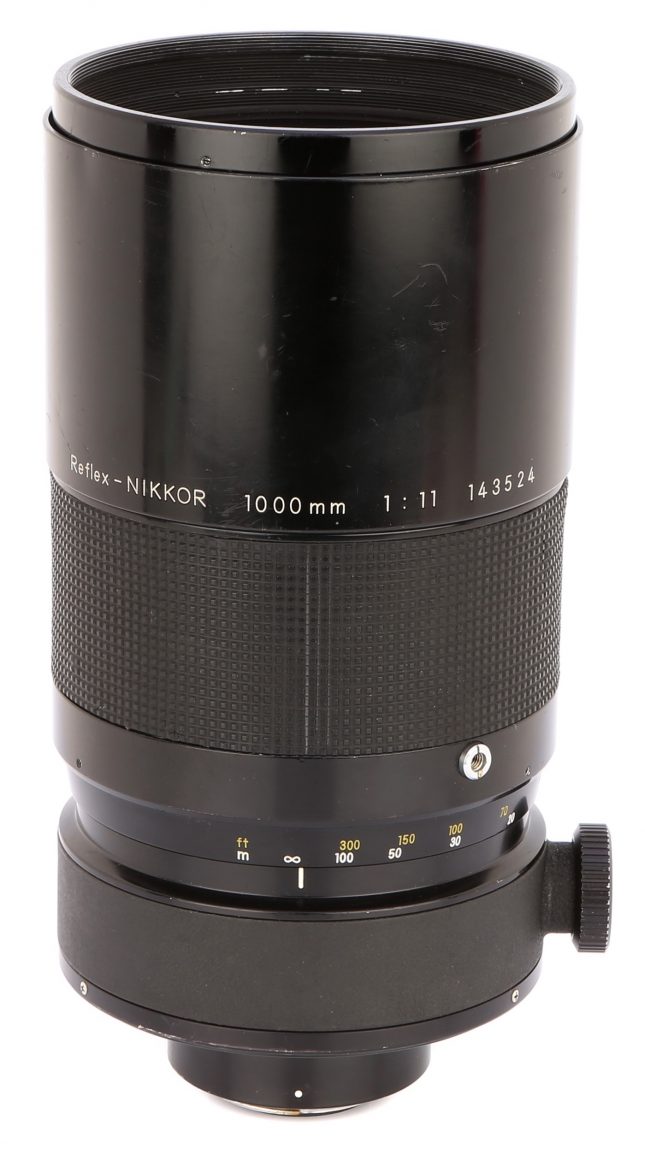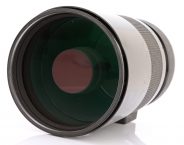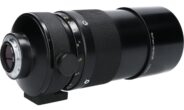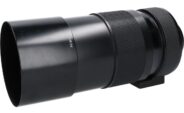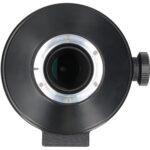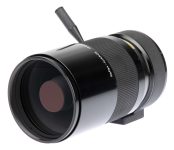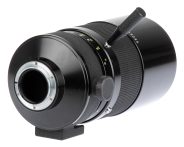Nikon Reflex-Nikkor 1000mm F/11
Super telephoto prime lens • Film era • Discontinued
- Announced:
- · 1976
- Production status:
- ● Discontinued
- Country of design:
- · Japan
- Original name:
- · Nikon Reflex-NIKKOR 1000mm 1:11
- Class:
- · Ultra-slow full-frame super telephoto prime lens
- · Mirror/Reflex lens
- System:
- · Nikon F (1959)
Model history (2)
| ■Nippon Kogaku / Nikon Reflex-Nikkor[·C] 1000mm F/11 | -- | 5 - 5 | 8.00m | -- | 1966 ● | |
| ■Nikon Reflex-Nikkor 1000mm F/11 | -- | 5 - 5 | 8.00m | -- | 1976 ● | |
Specification
| Optical design: | |
| 35mm full frame | |
| 1000mm | |
| F/11 | |
| 5 elements in 5 groups | |
| Nikon F [46.5mm] | |
| 2.5° (35mm full frame) | |
| Diaphragm mechanism: | |
Diaphragm type: | Fixed |
Aperture control: | None |
| Focusing: | |
| 8m | |
| 1:7 | |
Focusing modes: | Manual focus only |
Manual focus control: | Focusing ring |
| Physical characteristics: | |
| 1900g | |
| ⌀119×233.5mm | |
| Accessories: | |
| Removable front filters are not accepted | |
| Rear screw-type 39mm | |
| Built-in telescopic round | |
| Nikon Teleconverter TC-14B → 1400mm F/15.4 | |
| Nikon Teleconverter TC-300 → 2000mm F/22 | |
| Nikon Teleconverter TC-301 → 2000mm F/22 |
Sources of data
- Manufacturer's technical data.
- Nikkor lenses booklet (1984).
- Nikkor lenses sales manual (January 1979).
- Nikon dealer notebook pages.
- Nikon Sales Manual (June 1978).
- Nikon dealer catalogue.
- Nikon Full Line Product Guide (1996-1997) (August 1996).
Manufacturer description #1
Ideal for photographing shy or dangerous animals. Powerful frame-filling 20X magnification. Outstanding picture quality. Very compact and light for its long focal length. Accepts 39mm bayonet filters. Built-in lens hood.
Manufacturer description #2
FOREWORD
The Reflex-Nikkor 1000mm f/11 is a super-telephoto catadioptric-type lens offering exceptionally compact size that makes for easier, even hand-held shooting. The use of a mirror construction in this lens makes for the drastically reduced overall length, and also provides for excellent correction of chromatic aberration (normally high in a lens of this focal length); chromatic aberration correction afforded by the Reflex-Nikkor is so great, in fact, that this lens does not require refocusing for infrared photography. Further enhancing optical performance is the use of NIC (Nikon Integrated Coating) on air-to-glass surfaces; with NIC, flare and ghost are effectively controlled for outstanding results. The rear of the lens is fitted with a threaded mount that accepts Nikon 39mm screw-in filters (five are provided with the lens); this feature is particularly useful for control of exposures via neutral density (ND) filters (the lens has a fixed aperture) of various densities. Other features of the Reflex-Nikkor 1000mm f/11 include the built-in tripod mounting collar, the slip-out lens hood, and close focusing to 8m (25 ft).
FOCUSING
Focusing with the Reflex-Nikkor 1000mm f/11 is particularly easy due to the compact lens size. And, as a further aid, the focusing ring is provided with two threaded mounting locations for attachment of the focusing handle at the point most convenient for operation. Simply screw the handle into the ring at the desired location and turn the ring via the handle until the image appears sharp and crisp in the camera's focusing screen. It should be noted that the focusing ring can be turned 10° past the normal infinity position to take into account the coefficients of expansion and contraction.
USING THE FILTERS
The Reflex-Nikkor 1000mm f/11 is provided with a set of five filters for attaching individually to the rear of the lens. To attach a filter, remove the lens from the camera body in the normal way and simply screw the desired 39mm filter onto the threaded filter mount provided at the rear of the lens. Note that the lens comes with the L37C filter mounted on the lens, with the remaining four filters stored in the filter case in the flap of the lens case; one filter must be mounted at all times on the lens. In addition to the supplied set of five 39mm-diameter filters, the following 39mm screw-in filters are available as optional equipment: Skylight (L1BC), Medium Yellow (Y48), Deep Yellow (Y52), Red (R60), Neutral Density (ND2X and ND8X), Amber (A12), Medium Blue (B8), and Deep Blue (B12). The following table details the various 39mm filters available from Nikon.
OBTAINING CORRECT EXPOSURE
Your lens is the fixed-aperture type and will not couple with the TTL exposure metering system that may be built into some camera bodies. To get the correct exposure, please refer to the stopped-down exposure measurement section in the camera's instruction manual.
Remember that even if you set the camera to its top shutter speed, you won't be able to obtain correct exposure. A rule of thumb is to use the neutral density filter.
CONTROLLING THE EXPOSURE
Since the Reflex-Nikkor is fitted with a fixed f/11 aperture, exposure adjustments are possible only via the use of neutral density filters (or by adjusting the camera's shutter speed). Nikon offers three different ND filters (the ND4X is provided with the lens) having exposure factors of 2X, 4X and 8X, respectively, to enable effective aperture settings of f/16, f/22 and f/32 with the Reflex-Nikkor 1000mm f/11.
Typical characteristics of mirror (reflex) lenses
- Catadioptric system consisting of curved mirrors and optical glass;
- Much shorter, lighter and less expensive designs than conventional super telephoto lenses;
- Outstanding correction of chromatic aberrations;
- Since the aperture is fixed, neutral density filters are used to obtain a smaller aperture;
- Doughnut-shaped out-of-focus highlights.
Notes
- This non-AI lens was designed for Nikon F, F2, Nikkormat FS, FT, FT2, FTN, EL, ELW 35mm film SLR cameras.
- Non-AI lenses cannot be used on Nikon digital SLR cameras (except for the Df) or late (AI) film SLR cameras. However, non-AI lenses can be fitted to Nikon FM, FE, EL2, F3, F4 and Nikkormat FT3 cameras which used the AI metering system but allowed the metering coupling lever to be disengaged. The F5 could have this mechanism fitted as an optional extra. Non-AI lenses can be also fitted to the Nikon F2A and F2AS cameras because the AI mechanism was fitted to the removable metering prism.
Other super telephoto prime lenses in the Nikon F system
| ■Nikon F mount (6) | |||||||||
| Nippon Kogaku / Nikon Reflex-Nikkor[·C] 500mm F/8 | -- | 5 - 3 | 4.00m | ⌀88 | 1968 ● | ||||
| Nikon Reflex-Nikkor 500mm F/8 | -- | 6 - 6 | 1.50m | ⌀82 | 1983 ● | ||||
| Nippon Kogaku Reflex-Nikkor 500mm F/5 | -- | 5 - 4 | 15.00m | ⌀122 | 1961 ● | ||||
| Nippon Kogaku / Nikon Reflex-Nikkor[·C] 1000mm F/11 | -- | 5 - 5 | 8.00m | -- | 1966 ● | ||||
| Nippon Kogaku Reflex-Nikkor 1000mm F/6.3 | -- | 3 - 2 | 30.00m | -- | 1959 ● | ||||
| Nikon Reflex-Nikkor[·C] 2000mm F/11 | -- | 5 - 5 | 18.00m | -- | 1970 ● | ||||
Lenses with similar focal length
| ■Nikon F mount (2) | |||||||||
| Makina Makinon 1000mm F/11 Reflex MC | -- | ? - ? | 5.00m | ● | |||||
| Sigma MF 1000mm F/13.5 Mirror Telephoto Multi-Coated | -- | 6 - 6 | 5.00m | ⌀86 | 1981 ● | ||||
| ■Interchangeable mount (6) | |||||||||
| Zoomar Muenchen Reflectar 1000mm F/8 | -- | 4 - ? | 6.00m | -- | 1970 ● | ||||
| MTO-1000A 1100mm F/10.5 [T] akaМТО 1000А 1100mm F/10.5 | -- | 5 - ? | 10.00m | ⌀120 | ● | ||||
| MTO-1000AM 1100mm F/10.5 [T] akaМТО-1000 АМ 1100mm F/10.5 | -- | 5 - ? | 10.00m | ⌀120 | ● | ||||
| MTO-11SA 1000mm F/10 MC [T] akaМТО-11СА 1000mm F/10 МС | -- | ? - ? | 8.00m | ⌀116 | ● | ||||
| MTO-11 1000mm F/10 MC [T] akaМТО-11 1000mm F/10 МС | -- | ? - ? | 8.00m | ⌀120 | ● | ||||
| Carl Zeiss Mirotar 1000mm F/5.6 | -- | 5 - 5 | 12.00m | -- | 1974 ● | ||||
